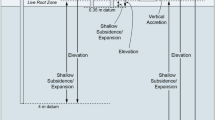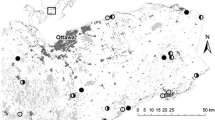Abstract
Land-surface subsidence and erosion are the principal processes that form accommodation space in interior coastal wetlands when they are converted to open water. The relative contribution of subsidence and erosion to wetland loss can be estimated by comparing elevations and vertical offsets of stratigraphic contacts that are correlated between adjacent sediment cores. Accommodation-space measurements assume that wetland-sediment thicknesses and the elevation of stratigraphic contacts were originally nearly uniform over short horizontal distances (tens to hundreds of meters). The accommodation space attributable to erosion equals the difference in wetland-sediment thickness between wetland cores and adjacent open-water cores taken at formerly emergent wetland sites. The accommodation space attributable to subsidence equals the elevation difference of a stratigraphic marker correlated between the two cores using the wetland core as the reference standard. Together, subsidence plus erosion at an open-water core location equals the accommodation space created by land loss, which is the difference between the adjacent emergent wetland elevation and the existing water depth.
Similar content being viewed by others
Literature Cited
Barras, J. A., J. C. Bernier, and R. A. Morton. 2008. Land area change in coastal Louisiana-A multidecadal perspective (from 1956 to 2006). U.S. Geological Survey Scientific Investigations Map 3019, scale 1:250,000.
Boumans, R. M. J. and J. W. Day Jr. 1993. High precision measurements of sediment elevation in shallow coastal areas using a sediment-erosion table. Estuaries 16: 375–80.
Cahoon, D. R., P. E. Marin, B. K. Black, and J. C. Lynch. 2000. A method for measuring vertical accretion, elevation, and compaction of soft, shallow-water sediments. Journal of Sedimentary Research 70: 1250–53.
Dahl, T. E. 2000. Status and trends of wetlands in the conterminous United States 1986 to 1997. U.S. Department of the Interior, Fish and Wildlife Service, Washington, DC, USA.
Jervey, M. T. 1988. Quantitative geological modeling of siliciclastic rock sequences and their seismic expression. p. 47–69.In C. K. Wilgus, B. S. Hastings, C. A. Ross, H. Posamentier, J. Van Wagoner, and C. G. St. C. Kendall (eds.) Sea-level changes: An integrated approach. Society of Economic Paleontologists and Mineralogists, Special Publication 42.
Jowsey, P. C. 1966. An improved peat sampler. New Phytologist 65: 245–48.
Kuecher, G. J. 1994. Geologic framework and consolidation settlement potential of the Lafourche Delta, topstratum valley fill: Implications for wetland loss in Terrebonne and Lafourche Parishes, Louisiana. Ph.D. Dissertation, Louisiana State University, Baton Rouge, La, USA.
Lanesky, D. E., B. W. Logan, R. G. Brown, and A. C. Hine. 1979. A new approach to portable vibracoring underwater and on land. Journal of Sedimentary Research 49: 654–57.
Leibowitz, S. G. and J. M. Hill. 1987. Spatial analyses of Louisiana coastal land loss, v. II, p. 331–55.In R. E. Turner and D. R. Cahoon (eds.) Causes of wetland loss in the coastal central Gulf of Mexico. Minerals Management Service Outer Continental Shelf (OCS) Study MMS87-0120, technical narrative.
Morton, R. A. 1991. Response of Holocene depositional systems tracts to sediment influx, northern Gulf of Mexico. Proceedings of Gulf Coast Section Society of Economic Paleontologists and Mineralogists Twelfth Annual Research Conference, Houston, TX, USA.
Morton, R. A. and W. A. White. 1997. Characteristics of and corrections for core shortening in unconsolidated sediments. Journal of Coastal Research 13: 761–69.
Morton, R. A., N. A. Purcell, and R. Peterson. 2001. Field evidence of subsidence and faulting induced by hydrocarbon production in coastal southeast Texas. Transactions Gulf Coast Association of Geological Societies 51: 239–48.
Morton, R. A., G. Tiling, and N. F. Ferina. 2003. Causes of hotspot wetland loss in the Mississippi delta plain. Environmental Geosciences 10: 71–80.
Morton, R. A., J. C. Bernier, and J. A. Barras, and N. F. Ferina. 2005. Rapid subsidence and historical wetland loss in the south-central Mississippi delta plain: Likely causes and future implications: U. S. Geological Survey Open-File Report 2005-16. http://pubs.usgs.gov/of/2005/1216/.
Morton, R. A., J. C. Bernier, and J. A. Barras. 2006. Evidence of regional subsidence and associated interior wetland loss induced by hydrocarbon production, Gulf coast region, USA. Environmental Geology 50: 261–74.
National Research Council. 2006. Drawing Louisiana’s new map. National Academies Press, Washington, DC, USA.
Reed, D. J. (ed.) Status and trends of hydrologic modification, reduction in sediment availability, and habitat loss/modification in the Barataria-Terrebonne estuarine system. Barataria-Terrebonne National Estuary Program Publication No. 20, Thibodaux, LA, USA.
Author information
Authors and Affiliations
Corresponding author
Rights and permissions
About this article
Cite this article
Morton, R.A., Bernier, J.C. & Buster, N.A. Simple methods for evaluating accommodation space formation in coastal wetlands. Wetlands 29, 997–1003 (2009). https://doi.org/10.1672/09-025D.1
Received:
Accepted:
Issue Date:
DOI: https://doi.org/10.1672/09-025D.1




